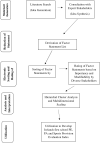School-based physical education, physical activity and sports provision: A concept mapping framework for evaluation
- PMID: 37352181
- PMCID: PMC10289340
- DOI: 10.1371/journal.pone.0287505
School-based physical education, physical activity and sports provision: A concept mapping framework for evaluation
Abstract
Objective: Physical education, physical activity and sports provision are important factors in whole school health promotion, however, a standardised evaluation framework to evaluate the contribution of these components is lacking. A framework that accounts for the distinct structures and associated factors, that impact upon provision would facilitate a more coherent evaluation.
Methods: A concept mapping methodology, involving the generation of factors relevant to school physical education, physical activity and sports provision and their subsequent thematic and numeric rating and sorting was utilised. Concept mapping effectively gathers, integrates, and visually and numerically represents the composite thinking of a group of relevant and expert stakeholders around a complex social phenomenon. Following a review of the extant literature and synthesis among 20 expert stakeholders, a list of 95 factor statements relevant to school physical education, physical activity and sports provision were developed.
Results: Each factor statement was rated and sorted by 197 multi-disciplinary participants. An eight-cluster framework that demonstrated good validity (stress value: 0.266), was derived from the data based on: 1. Partnerships and Pupil Centered Physical Education; 2. Physical Activity and Sports; 3. School Demographics; 4. Equipment, Facilities and Budget; 5. Extra Costs; 6. Curriculum and Policy; 7. School Management and 8. Timetable. Statements within the cluster on school management received the highest mean importance and modifiability ratings while statements within the cluster on school demographics received the lowest mean importance and modifiability ratings.
Conclusions: Eight overarching structures which account for school physical education, physical activity and sports provision have been identified. Within each of these, structures and overall factors of greatest importance and modifiability have been illuminated. Findings stemming from this rigorous methodology, provide the foundation for the development of a national provision evaluation index to inform both school-level and national policy and actions. It is recommended the current methodology is replicated in other nations to gain corresponding insights.
Copyright: © 2023 Rocliffe et al. This is an open access article distributed under the terms of the Creative Commons Attribution License, which permits unrestricted use, distribution, and reproduction in any medium, provided the original author and source are credited.
Conflict of interest statement
The authors have declared that no competing interests exist.
Figures
Similar articles
-
A provincial study of opportunities for school-based physical activity in secondary schools.J Adolesc Health. 2006 Jul;39(1):80-6. doi: 10.1016/j.jadohealth.2005.10.004. J Adolesc Health. 2006. PMID: 16781965
-
Evaluation of practice to promote physical activity in schools in a unitary authority in England.Public Health. 2020 May;182:155-160. doi: 10.1016/j.puhe.2020.02.014. Epub 2020 Apr 19. Public Health. 2020. PMID: 32320906
-
A school-based intervention to promote physical activity among adolescent girls: rationale, design, and baseline data from the Girls in Sport group randomised controlled trial.BMC Public Health. 2011 Aug 19;11:658. doi: 10.1186/1471-2458-11-658. BMC Public Health. 2011. PMID: 21854609 Free PMC article. Clinical Trial.
-
American Medical Society for Sports Medicine position statement: concussion in sport.Br J Sports Med. 2013 Jan;47(1):15-26. doi: 10.1136/bjsports-2012-091941. Br J Sports Med. 2013. PMID: 23243113 Review.
-
School-based physical activity promotion: a conceptual framework for research and practice.Child Obes. 2014 Apr;10(2):100-6. doi: 10.1089/chi.2013.0134. Epub 2014 Mar 21. Child Obes. 2014. PMID: 24655311 Review.
Cited by
-
Development and validation of a measurement instrument for student assessment of quality physical education in Chinese secondary schools.PLoS One. 2025 Jun 5;20(6):e0324227. doi: 10.1371/journal.pone.0324227. eCollection 2025. PLoS One. 2025. PMID: 40471878 Free PMC article.
References
-
- Department of Health. Get Ireland Active–The National Physical Activity Plan. Government of Ireland. 2016.
-
- World Health Organization. WHO Guidelines on Physical Activity and Sedentary Behaviour. Geneva, 2020. https://apps.who.int/iris/bitstream/handle/10665/337001/9789240014886-en... - PubMed
-
- World Health Organisation. Global Action Plan on Physical Activity 2018–2030. Geneva, 2018. https://apps.who.int/gb/ebwha/pdf_files/EB142/B142_R5-en.pdf.
-
- European Parliament. Physical Education in EU schools. Strasbourg, 2016. https://www.europarl.europa.eu/thinktank/en/document/EPRS_BRI(2016)59
-
- World Health Organization. Global status report on physical activity 2022. Geneva, 2022. https://www.who.int/publications/i/item/9789240059153.
Publication types
MeSH terms
LinkOut - more resources
Full Text Sources




